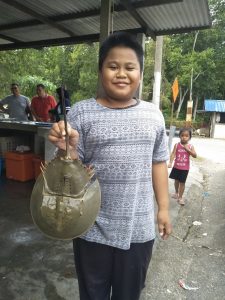Horseshoe crabs are prehistoric animals that existed on earth well before the dinosaurs. They have 10 legs and a hard exoskeleton (shell), and while they look like ancient crabs, they are actually more closely related to spiders and scorpions. The ‘horseshoe’ in its name actually comes from the shape of its head: U-shaped like a horse’s shoe.

Studies of these species show that their populations are in decline because of habitat damage and human consumption. A popular ‘exotic food’ in Malaysia, people catch it to eat its eggs, which means they are not able to repopulate before being caught. It is also taken by researchers (in large numbers!) to study its blue blood, which has a substance vital to the study of cancer cures. Horseshoe crabs can live until they are 30 years old and are only able to reproduce at 9 to 12 years. This means that overharvesting causes great damage to their continued existence.
Join Kelab Alami (kelabalami.weebly.com) on a mangrove or seagrass walk where you might be able to meet live horseshoe crabs in our shallows.


